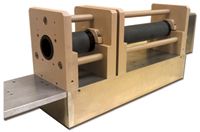Creation of a New IMS Analyzer Platform with High Resolving Power
PHOTONIS USA, Inc.
Ion mobility spectrometry (IMS) has become widely accepted for the detection of chemical warfare agents, explosives, and narcotics as well as for pharmaceutical quality control and pesticide screening of food. Most currently available commercial IMS units have a resolving power of 10–60.
In order to minimize the frequency of false positive and false negative results that create delays and cost overruns, it has become necessary to design and construct an ion mobility spectrometer with high separation power without compromising instrument simplicity, serviceability, and cost. Such an instrument can be used in applications where high volume, accuracy, and speed of specific contaminant identifications are critical, such as those involving product safety, composition analysis, and environmental control.
PHOTONIS has designed a new IMS analyzer platform designed for simple integration with most mass spectrometers, GCs, and other analytical instruments. The new IMS analyzer unit combines PHOTONIS' patented Resistive Glass products with a novel robust ion gate technology to create an IMS analyzer which improves resolution and simplifies serviceability. This new unit provides significantly higher resolving power (64–150) when compared to most currently available IMS instruments.

Figure 1: IMS analyzer prototype.
In this new IMS analyzer platform, key components made from PHOTONIS Resistive Glass were designed to replace conventional lens assemblies. Reaction and drift regions of the ion mobility spectrometer were fabricated using Resistive Glass technology, as they enhance ion throughput and simplify construction.
Resistive Glass is manufactured in a patented process by PHOTONIS in which an electric field is created to guide or direct charged particles. It consists of alkali-doped lead silicate glass that has been reduced to make the surface a semiconductor. Resistive Glass can be used to manufacture capillary inlet tubes, drift tubes, ion guides, ion mirrors, collision cells, conversion diodes, or voltage dividers.
The use of Resistive Glass drift tubes in an IMS Analyzer provides key benefits, such as uniform electric fields with minimal radial inhomogeneities and ease of construction. In addition, the single-piece construction allows uniform flow of drift gas without the need for additional containment.
A new novel and robust ion gating assembly was also created for this IMS Analyzer. It comes equipped with a Bradbury-Nielsen type electronic gate, built using photo-etching technology. The unique approach of the ion gate design results in a device that is robust, high-performance, low cost, and simple to assemble when compared to the conventional winding technique. The ability to handle entire grid sets rather than individual wires to insure precise positioning of all wires provides a distinct advantage to traditional approaches in terms of resolution and serviceability.
The new IMS unit can be operated at room temperature but also features integral heaters that can be operated at temperatures up to 150 °C.
This new IMS Analyzer is designed to be scaled or customized to interface with a wide variety of instruments to simplify IMS analysis in applications where a narrow range of contaminants need to be quickly identified. Its unique design allows the user to quickly and inexpensively perform a simple IMS analysis and receive fast, accurate results. Its higher resolving power (64–150) lowers the probability of false positive and false negative results for a more efficient analysis.
PHOTONIS USA, Inc.
660 Main Street, Sturbridge, MA 01566
tel. (508) 347-4000, fax (508) 347-3849
Website: www.photonis.com

Free Poster: NDSRI Risk Assessment and Trace-Level Analysis of N-Nitrosamines
April 25th 2025With increasing concern over genotoxic nitrosamine contaminants, regulatory bodies like the FDA and EMA have introduced strict guidelines following several high-profile drug recalls. This poster showcases a case study where LGC and Waters developed a UPLC/MS/MS method for quantifying trace levels of N-nitroso-sertraline in sertraline using Waters mass spectrometry and LGC reference standards.
New TRC Facility Accelerates Innovation and Delivery
April 25th 2025We’ve expanded our capabilities with a state-of-the-art, 200,000 sq ft TRC facility in Toronto, completed in 2024 and staffed by over 100 PhD- and MSc-level scientists. This investment enables the development of more innovative compounds, a broader catalogue and custom offering, and streamlined operations for faster delivery. • Our extensive range of over 100,000 high-quality research chemicals—including APIs, metabolites, and impurities in both native and stable isotope-labelled forms—provides essential tools for uncovering molecular disease mechanisms and exploring new opportunities for therapeutic intervention.
New Guide: Characterising Impurity Standards – What Defines “Good Enough?”
April 25th 2025Impurity reference standards (IRSs) are essential for accurately identifying and quantifying impurities in pharmaceutical development and manufacturing. Yet, with limited regulatory guidance on how much characterisation is truly required for different applications, selecting the right standard can be challenging. To help, LGC has developed a new interactive multimedia guide, packed with expert insights to support your decision-making and give you greater confidence when choosing the right IRS for your specific needs.
Using the Carcinogenic Potency Categorisation Approach (CPCA) to Classify N-nitrosamine Impurities
April 25th 2025Learn how to manage nitrosamine impurities in pharmaceuticals with our free infographic. Discover how the CPCA approach establishes acceptable intake limits and guides the selection of NDSRI reference samples. Stay compliant and ensure safety with our ISO-accredited standards.

.png&w=3840&q=75)

.png&w=3840&q=75)



.png&w=3840&q=75)



.png&w=3840&q=75)














